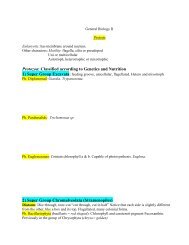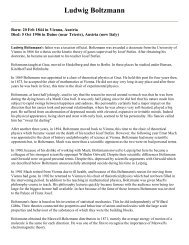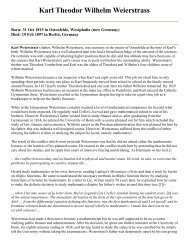Florence Nightingale
Florence Nightingale
Florence Nightingale
Create successful ePaper yourself
Turn your PDF publications into a flip-book with our unique Google optimized e-Paper software.
<strong>Florence</strong> <strong>Nightingale</strong><br />
Born: 12 May 1820 in <strong>Florence</strong>, Italy<br />
Died: 13 August 1910 in East Wellow, England<br />
<strong>Florence</strong> <strong>Nightingale</strong> is best remembered for her work as a nurse during the Crimean War and her contribution<br />
towards the reform of the sanitary conditions in military field hospitals. However, what is less well known<br />
about this amazing woman is her love of mathematics, especially statistics, and how this love played an<br />
important part in her life's work.<br />
Named after the city of her birth, <strong>Nightingale</strong> was born at the Villa Colombia in <strong>Florence</strong>, Italy, on 12 May<br />
1820. Her parents, William Edward <strong>Nightingale</strong> and his wife Frances Smith, were touring Europe for the first<br />
two years of their marriage. <strong>Nightingale</strong>'s elder sister had been born in Naples the year before. The <strong>Nightingale</strong>s<br />
gave their first born the Greek name for the city, which was Parthenope.<br />
William <strong>Nightingale</strong> had been born with the surname Shore but he had changed it to <strong>Nightingale</strong> after inheriting<br />
from a rich relative, Peter <strong>Nightingale</strong> of Lea, near Matlock, Derbyshire. The girls grew up in the country<br />
spending much of their time at Lea Hurst in Derbyshire. When <strong>Nightingale</strong> was about five years old her father<br />
bought a house called Embley near Romsey in Hampshire. This now meant that the family spent the summer<br />
months in Derbyshire, while the rest of the year was spent at Embley. Between these moves there were trips to<br />
London, the Isle of Wight, and to relatives.<br />
The early education of Parthenope and <strong>Florence</strong> was placed in the hands of governesses, later their Cambridge<br />
educated father took over the responsibility himself. <strong>Nightingale</strong> loved her lessons and had a natural ability for<br />
studying. Under her father's influence <strong>Nightingale</strong> became acquainted with the classics, Euclid, Aristotle, the<br />
Bible, and political matters.<br />
In 1840, <strong>Nightingale</strong> begged her parents to let her study mathematics instead of:-<br />
... worsted work and practising quadrilles,<br />
but her mother did not approve of this idea. Although William <strong>Nightingale</strong> loved mathematics and had<br />
bequeathed this love to his daughter, he urged her to study subjects more appropriate for a woman. After many<br />
long emotional battles, <strong>Nightingale</strong>'s parents finally gave their permission and allowed her to be tutored in<br />
mathematics. Her tutors included Sylvester, who developed the theory of invariants with Cayley. <strong>Nightingale</strong><br />
was said to be Sylvester's most distinguished pupil. Lessons included learning arithmetic, geometry and algebra<br />
and prior to <strong>Nightingale</strong> entered nursing, she spent time tutoring children in these subjects.<br />
<strong>Nightingale</strong>'s interest in mathematics extended beyond the subject matter. One of the people who also<br />
influenced <strong>Nightingale</strong> was the Belgium scientist Quetelet. He had applied statistical methods to data from<br />
several fields, including moral statistics or social sciences.<br />
Religion played an important part in <strong>Nightingale</strong>'s life. Her unbiased view on religion, unusual at the time, was<br />
owed to the liberal outlook <strong>Nightingale</strong> found in her home. Although her parents were from a Unitarian<br />
background, Frances <strong>Nightingale</strong> found a more conventional denomination preferable and the girls were<br />
brought up as members of the Church of England. On 7 February 1837 <strong>Nightingale</strong> believed she heard her<br />
calling from God, whilst walking in the garden at Embley, although at this time though she did not know what<br />
this calling was.
<strong>Nightingale</strong> developed an interest in the social issues of the time, but in 1845 her family was firmly against the<br />
suggestion of <strong>Nightingale</strong> gaining any hospital experience. Until then the only nursing that she had done was<br />
looking after sick friends and relatives. During the mid-nineteenth century nursing was not considered a suitable<br />
profession for a well-educated woman. Nurses of the time were lacking in training and they also had the<br />
reputation of being coarse, ignorant women, given to promiscuity and drunkenness.<br />
While <strong>Nightingale</strong> was on a tour of Europe and Egypt starting in 1849, with family friends Charles and Selina<br />
Bracebridge, she had the chance to study the different hospital systems. In early 1850 <strong>Nightingale</strong> began her<br />
training as a nurse at the Institute of St Vincent de Paul in Alexandria, Egypt, which was a hospital run by the<br />
Roman Catholic Church. <strong>Nightingale</strong> visited Pastor Theodor Fliedner's hospital at Kaiserswerth, near<br />
Düsseledorf, in July 1850. <strong>Nightingale</strong> returned to Kaiserswerth, in 1851, to undertake 3 months of nursing<br />
training at the Institute for Protestant Deaconesses and from Germany she moved to a hospital in St Germain,<br />
near Paris, run by the Sisters of Mercy. On returning to London in 1853 <strong>Nightingale</strong> took up the unpaid position<br />
as the Superintendent at the Establishment for Gentlewomen during Illness at No 1 Harley Street.<br />
March of 1854 brought the start of the Crimean War, with Britain, France and Turkey declaring war on Russia.<br />
Although the Russians were defeated at the battle of the Alma River, on 20 September 1854, The Times<br />
newspaper criticised the British medical facilities. In response to this <strong>Nightingale</strong> was asked in a letter from her<br />
friend Sidney Herbert, the British Secretary for War, to become a nursing administrator to oversee the<br />
introduction of nurses to military hospitals. Her official title was Superintendent of the Female Nursing<br />
Establishment of the English General Hospitals in Turkey. <strong>Nightingale</strong> arrived in Scutari, an Asian suburb of<br />
Constantinople, (now Istanbul), with 38 nurses on 4 November 1854 [2]:-<br />
... her zeal, her devotion, and her perseverance would yield to no rebuff and to no difficulty. She went steadily<br />
and unwearyingly about her work with a judgement, a self-sacrifice, a courage, a tender sympathy, and withal a<br />
quiet and unostentatious demeanour that won the hearts of all who were not prevented by official prejudices<br />
from appreciating the nobility of her work and character.<br />
Although being female meant <strong>Nightingale</strong> had to fight against the military authorities at every step, she went<br />
about reforming the hospital system. With conditions which resulted in soldiers lying on bare floors surrounded<br />
by vermin and unhygienic operations taking place it is not surprising that, when <strong>Nightingale</strong> first arrived in<br />
Scutari, diseases such as cholera and typhus were rife in the hospitals. This meant that injured soldiers were 7<br />
times more likely to die from disease in hospital,<br />
than on the battlefield. Whilst in Turkey,<br />
<strong>Nightingale</strong> collected data and organised a record<br />
keeping system, this information was then used as<br />
a tool to improve city and military hospitals.<br />
<strong>Nightingale</strong>'s knowledge of mathematics became<br />
evident when she used her collected data to<br />
calculate the mortality rate in the hospital. These<br />
calculations showed that an improvement of the<br />
sanitary methods employed would result in a<br />
decrease in the number of deaths. By February<br />
1855 the mortality rate had dropped from 60% to<br />
42.7%. Through the establishment of a fresh water<br />
supply as well as using her own funds to buy fruit,<br />
vegetables and standard hospital equipment, the<br />
mortality rate in the spring had dropped further to<br />
2.2%.<br />
<strong>Nightingale</strong> used this statistical data to create her<br />
Polar Area Diagram, or "coxcombs" as she called
them. These were used to give a graphical representation of the mortality figures during the Crimean War (1854<br />
- 56).<br />
The area of each coloured wedge, measured from the centre as a common point, is in proportion to the statistic<br />
it represents. The blue outer wedges represent the deaths from:-<br />
... preventable or mitigable zymotic diseases<br />
or in other words contagious diseases such as cholera and typhus. The central red wedges show the deaths from<br />
wounds. The black wedges in between represent deaths from all other causes. Deaths in the British field<br />
hospitals reached a peak during January 1855, when 2,761 soldiers died of contagious diseases, 83 from wounds<br />
and 324 from other causes making a total of 3,168. The army's average manpower for that month was 32,393.<br />
Using this information, <strong>Nightingale</strong> computed a mortality rate of 1,174 per 10,000 with 1,023 per 10,000 being<br />
from zymotic diseases. If this rate had continued, and troops had not been replaced frequently, then disease<br />
alone would have killed the entire British army in the Crimea.<br />
These unsanitary conditions, however, were not only limited to military hospitals in the field. On her return to<br />
London in August 1856, four months after the signing of the peace treaty, <strong>Nightingale</strong> discovered that soldiers<br />
during peacetime, aged between 20 and 35 had twice the mortality rate of civilians. Using her statistics, she<br />
illustrated the need for sanitary reform in all military hospitals. While pressing her case, <strong>Nightingale</strong> gained the<br />
attention of Queen Victoria and Prince Albert as well as that of the Prime Minister, Lord Palmerston. Her<br />
wishes for a formal investigation were granted in May 1857 and led to the establishment of the Royal<br />
Commission on the Health of the Army. <strong>Nightingale</strong> hid herself from public attention, and became concerned<br />
for the army stationed in India. In 1858, for her contributions to army and hospital statistics <strong>Nightingale</strong> became<br />
the first woman to be elected to be a Fellow of the Royal Statistical Society.<br />
In 1860, the <strong>Nightingale</strong> Training School and Home for Nurses based at St Thomas' Hospital in London, opened<br />
with 10 students. It was financed by the <strong>Nightingale</strong> Fund, a fund of public contributions set up during<br />
<strong>Nightingale</strong>'s time in the Crimea and had raised a total of 50,000. It was based around two principles. Firstly<br />
that the nurses should have practical training in hospitals specially organised for that purpose. The other was<br />
that the nurses should live in a home fit to form a moral life and discipline. Due to the foundation of this school<br />
<strong>Nightingale</strong> had achieved the transformation of nursing from its disreputable past into a responsible and<br />
respectable career for women. <strong>Nightingale</strong> responded to the British war office's request for advice on army<br />
medical care in Canada and was also a consultant to the United States government on army health during the<br />
American Civil War.<br />
For most of the remainder of her life <strong>Nightingale</strong> was bedridden due to an illness contracted in the Crimea,<br />
which prevented her from continuing her own work as a nurse. This illness did not stop her, however,<br />
campaigning to improve health standards; she published 200 books, reports and pamphlets. One of these<br />
publications was a book entitled Notes on Nursing (1860). This was the first textbook specifically for use in the<br />
teaching of nurses and was translated into many languages. <strong>Nightingale</strong>'s other published works included Notes<br />
on Hospitals (1859) and Notes on Nursing for the Labouring Classes (1861). <strong>Florence</strong> <strong>Nightingale</strong> deeply<br />
believed that her work had been her calling from God. In 1874 she became an honorary member of the<br />
American Statistical Association and in 1883 Queen Victoria awarded <strong>Nightingale</strong> the Royal Red Cross for her<br />
work. She also became the first woman to receive the Order of Merit from Edward VII in 1907.<br />
<strong>Nightingale</strong> died on 13 August 1910 aged 90. She is buried at St Margaret's Church, East Wellow, near Embley<br />
Park. <strong>Nightingale</strong> never married, although this was not from lack of opportunity. She believed, however, that<br />
God had decided she was one whom he:-<br />
... had clearly marked out ... to be a single woman.
The Crimean Monument, erected in 1915 in Waterloo Place, London, was done so in honour of the contribution<br />
<strong>Florence</strong> <strong>Nightingale</strong> had made to this war and the health of the army.<br />
Article by: J J O'Connor and E F Robertson based on a project by Suzanne Davidson.<br />
October 2003












![IL PRINCIPE – NICCOLÒ MACHIAVELLI [NA = Norton Anthology ]](https://img.yumpu.com/15277483/1/190x245/il-principe-niccolo-machiavelli-na-norton-anthology-.jpg?quality=85)



